1. The birth of airplanes and helicopteres
The history of aeronautics is a beautiful illustration of the long technological way which had to be covered to carry out an old dream of the Man: to fly like the birds.
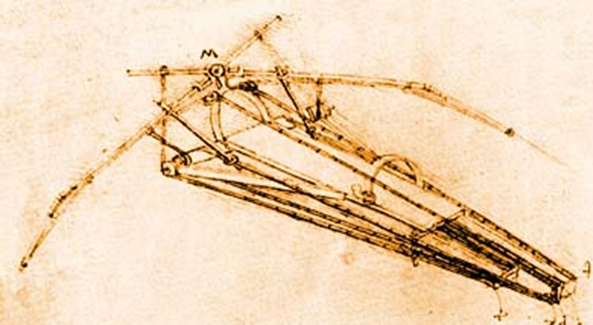
Leonardo's Human-Powered Ornithopter 1485
As the myth of Icare testifies, this dream goes back at least to Antiquity. One found the trace of several attempts at machines with beating wings imitating those of the birds.
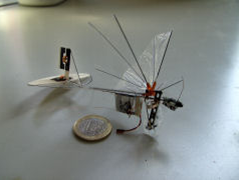 Micro Delphy from Delft University
Micro Delphy from Delft UniversityBut they were always unfruitful. One of the best known inventions was that of Leonardo da Vinci (1480-1519) and was called in French l’ ornithoptère. However, in reality this machine is unable to fly.
The discoveries are the fruit of an often enthralling work, requiring perseverance and whose intellectual advance is sometimes very complex and sinuous, often comprising outward journeys and returns. For example, the development of aeronautics was not done by adopting the principle of the beating wing. However, a new research orientation currently uses again this principle on the basis of “bionics”.This discipline consists in analyzing the behaviors met in nature and reproducing them in mechanisms, systems or materials. It is only very recently that the researchers succeeded in developing small autonomous planes, called “drones”, with beating wings comparable to small insects. The studies of the behavior of the wings of birds revealed the complexity of their mechanism. Their shapes adapt permanently to the flying conditions, and this mainly for the light birds. For the heavier birds, most of the flight is done in gliding flight. When one thinks of the size and the weight of an A380 Airbus, one measures the limits of the comparison.
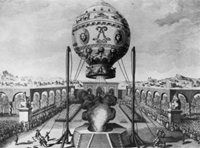
First human flight – 1783 Paris
The first successful effort to transport the men in the airs was that of the Montgolfier brothers (Paris - November 1783). It is entirely by chance that Joseph Montgolfier saw that hot air was lighter than cold air. While drying a shirt by a fireplace, the shirt inflated with hot air, and when narrowing the arrival of hot air, he could see it deflating. He then understood that he had just discovered what would enable him to carry out his dream and that of many others: to start the conquest of the sky. Before the flight of November 1783 with humans, they carried out tests with a sheep, a duck and a chicken to check viability with high-altitude.
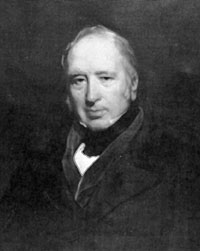
Sir Georges Cayley (the U.K. - 1773-1857)
As a child, Sir Georges Cayley (the U.K. - 1773-1857) was fascinated by the passion generated by the first flights of Montgolfières (French name of the invention of the Montgolfier brothers), but quickly he was persuaded that machines with fixed wings would be more powerful. Like his predecessors, he started by in-detail studying the flight of the birds but with a much more scientific approach: He studied the shapes of the wings, measured the weights, speeds of flights of the birds,… He built a system of revolving wing and measured the weight which it could raise for various speeds and various angles. These experiments enabled him to apprehend the theory showing the lift of a wing, basic principle of the flight. He applied this principle to build a sailplane (1849) with which he accomplished the first flight in 1853. On the basis of the new knowledge acquired through these experiments and with this new concept of lift, he defined the basic principle of the modern plane. He was the first who understood that it is necessary to dissociate the force that raises the wing of the plane, lift, from the force that propels the plane. The latter must be generated by an independent means, a propeller driven by an explosion or gas engine. Furthermore, a rudder will make it possible to control the direction of the plane.
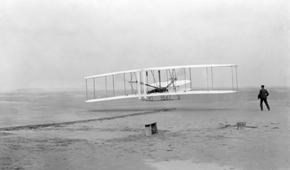
First Motorised flight of the Wright's brothers in 1903
The first flight is allotted to the brothers Wilbur and Orville Wright, on December 17, 1905, in North Carolina (USA). Their plane, Flyer, took very largely advantage of the experiments undertaken by their contemporary as for example Octave Chanute (USA) which on the basis of the work of Lilienthal (Germany), developed very powerful biplane sailplanes whose stability made it possible to repeat the flights. The first part of their investigations thus started with the construction of sailplanes that they developed in close cooperation with Chanute, who helped them to progress in their projects. The experience gained with their sailplane allowed them to consider the motorized flight. Since they could not find an automobile engine meeting their needs, the Wright brothers built their own engine. After a first attempt which resulted into an accident, they made a success of a first flight of 12 seconds during which the plane had covered a distance of 36 meters. After the Wright’s, the development of aeronautics became exponential. At the beginning of its history, the researchers developed planes which went always faster and which flew higher. Between 1900 and 1970, the speed of the planes jumped from the order of 10 km/h to 2000 km/h, whereas in same time the altitude of flight raised from a few meters to 100 km. Today, the constraints of ecological and of cost nature bring another view on the development of civil aircrafts and the international programs are directed towards the construction of less polluting planes in terms of fuel consumption, but also of noise.
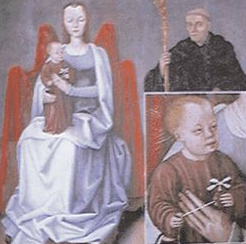
Triptych, the Virgin and St Benoit, 15th century
Another category of aircraft develops in parallel: the helicopter. Since IVe century BC , the Chinese were flying small toys in the form of propeller on the principle of the helicopter to fascinate the children. This toy is shown opposite in a triptych representing the virgin and St Benoit dating from the 15th century.
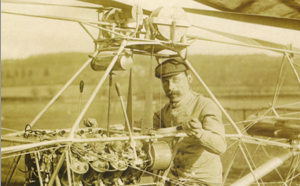
Paul Cornu flying his helicopter in 1907
A significant advance occurred in 1907, year of the first true takeoff in the world. It seems that it was achieved in Normandy (France) in Coquainvilliers, close to Lisieux. This machine of 203 kilos was invented and controlled by Paul Cornu. For the first time, a machine is freed from the ground without elan with a man on board. This date of November 13, 1907 is quoted in all the stories of aviation, as being that of the first free flight of a helicopter with its pilot.









